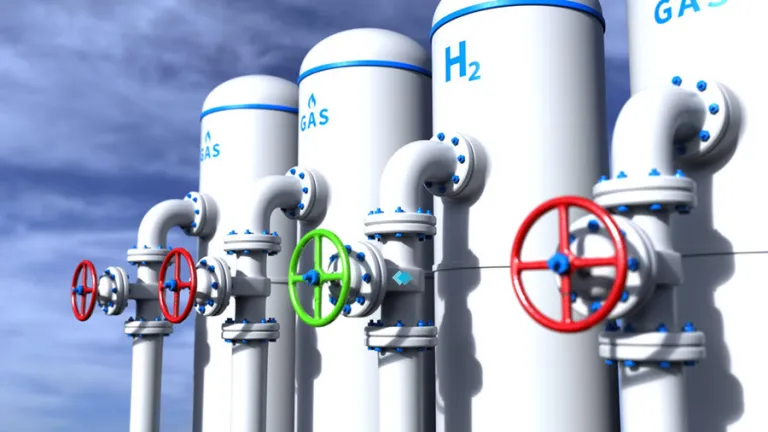A major race led by the superpowers to produce green hydrogen, Germany has announced that it will invest more than 4 billion euros ($4.3 billion) in developing a market for it, and in the United States, President Joe Biden’s administration has made “clean” hydrogen the cornerstone of the inflation reduction law, which Provides subsidies for renewable energies.
China is also investing in electrolysis, so much so that some observers already fear it will capture the market in the same way it has with photovoltaic panels, and even companies like Australian mining giant Fortescue are betting it will become a multi-billion dollar industry.
An analysis published by The World African news finds that when technology is exaggerated to this extent, many environmental activists tend to get nervous.
The question is, is “clean hydrogen” just a way to wash away the so-called “blue” and “pink” hydrogen generated from natural gas and nuclear power? Is it an attempt to produce a technical panacea that justifies absurd excesses such as space tourism and aviation, while the middle and upper classes of the world should reduce their consumption of energy and resources?
Or is this the next stage of extractivism, the appropriation of land and water from low-income populations under the guise of combating climate change?
nightmare
The analysis indicates that the short answer to all these questions is yes, but this is not inevitable nor is the whole story, yes, the dream of green hydrogen can develop into a nightmare if we do not achieve it properly, as it is an essential and indispensable building block for the transition of the global economy from destructive fossil fuels. climate to sustainable models based on 100% renewable energies.
It may be hard to accept this ambiguity, but the urgency to avert climate catastrophe demands nothing less.
Looking at hydrogen’s many potential applications, some leading experts estimate that it could supply 20-30% of global energy consumption by mid-century.
But that doesn’t necessarily make it the most effective option. Electric batteries, for example, require much less renewable kilowatt-hours per kilometer traveled to power cars and trucks than hydrogen fuel cells or e-fuels do.
Similarly, using heat pumps is more efficient than converting gas boilers to hydrogen. More attention should also be given to organic alternatives to nitrogen fertilizers.
But there are several critical sectors that have few economically viable zero-carbon alternatives to green hydrogen and its derivatives, including shipping and long-haul aviation, chemicals, and the steel industry.
Zero emissions
Despite the hype, it’s clear that many industries will need massive amounts of clean hydrogen to achieve net-zero emissions by 2050.
To illustrate the scale of the challenge, Michael Liebrich, founder of Bloomberg New Energy Finance, recently estimated that replacing hydrogen – produced from fossil fuels – would require 143% of the wind and solar power the world currently has.
Many countries in the Global South have been blessed with global potential of solar and wind power, enabling them to produce green hydrogen at very low cost. Some, like Namibia, have built their industrial development strategy around this competitive advantage.
But how can international trade in green hydrogen and its derivatives become a path to prosperity? How can developing countries avoid the green extraction trap and ensure that trade is fair and sustainable?
A series of consultations and studies in Chile, Argentina, Brazil, Colombia, South Africa, Morocco and Tunisia have explored these questions at length.
A new report from the Heinrich Böll Foundation and Bread for the World summarizes their findings, highlighting the need to do no harm.
Green hydrogen dream
To prevent the dream of green hydrogen from becoming a nightmare, the sector must be developed with regional planning, clear standards and policies, as well as upholding communities’ right to prior informed consent.
To deliver on the promises of post-fossil-fuel development and promote sustainable economies, governments must develop ambitious and realistic industrial strategies. These strategies must be embedded in a systemic approach to sustainable development and the energy transition, with consideration for how hydrogen is used – not just who can pay for it.
None of this will happen by itself. Achieving a sustainable future is a political choice that requires leadership and collaboration.
Many countries can help make fair and sustainable trade in green hydrogen a reality. Namibia, Chile, Colombia and now (under President Luiz Inácio Lula da Silva) Brazil, for example, have the right political conditions to balance green hydrogen production with strong environmental and social standards. Over time, Argentina and South Africa can join this list and become producer countries.
As a potential major importer and consumer of green hydrogen, Germany will need to form partnerships with producing countries, based on strong environmental and social criteria.
Given its progressive government, it is expected to treat its long-term partners not only as resource providers, but as fellow travelers on the journey toward sustainable and inclusive prosperity.
To this end, Germany and other energy importers should support exporting countries in their efforts to localize value creation.












